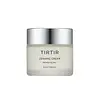What's inside
What's inside
 Key Ingredients
Key Ingredients

 Benefits
Benefits

 Concerns
Concerns

 Ingredients Side-by-side
Ingredients Side-by-side

Water
Skin ConditioningGlycerin
HumectantOlea Europaea Fruit Oil
MaskingButylene Glycol
HumectantMacadamia Ternifolia Seed Oil
EmollientCyclopentasiloxane
EmollientHamamelis Virginiana Extract
AntiseborrhoeicBeeswax
Emulsion StabilisingCetearyl Alcohol
EmollientCetyl Ethylhexanoate
EmollientCyclohexasiloxane
EmollientIsopropyl Myristate
EmollientPolyglyceryl-3 Methylglucose Distearate
EmulsifyingPolysorbate 60
EmulsifyingStearic Acid
CleansingPEG-100 Stearate
Glyceryl Stearate
EmollientDimethiconol
EmollientSodium Polyacrylate
Absorbent1,2-Hexanediol
Skin ConditioningCaprylyl Glycol
EmollientButyrospermum Parkii Butter
Skin ConditioningCamellia Sinensis Leaf Extract
AntimicrobialRosmarinus Officinalis Leaf Extract
AntimicrobialChamomilla Recutita Flower Extract
MaskingCentella Asiatica Extract
CleansingGlycyrrhiza Glabra Root Extract
BleachingPolygonum Cuspidatum Root Extract
AntioxidantScutellaria Baicalensis Root Extract
AstringentIllicium Verum Fruit Extract
PerfumingDisodium EDTA
Betaine
HumectantAllantoin
Skin ConditioningTrehalose
HumectantPolysorbate 20
EmulsifyingPolyglutamic Acid
Skin ConditioningXylitol
HumectantCeramide NP
Skin ConditioningWater, Glycerin, Olea Europaea Fruit Oil, Butylene Glycol, Macadamia Ternifolia Seed Oil, Cyclopentasiloxane, Hamamelis Virginiana Extract, Beeswax, Cetearyl Alcohol, Cetyl Ethylhexanoate, Cyclohexasiloxane, Isopropyl Myristate, Polyglyceryl-3 Methylglucose Distearate, Polysorbate 60, Stearic Acid, PEG-100 Stearate, Glyceryl Stearate, Dimethiconol, Sodium Polyacrylate, 1,2-Hexanediol, Caprylyl Glycol, Butyrospermum Parkii Butter, Camellia Sinensis Leaf Extract, Rosmarinus Officinalis Leaf Extract, Chamomilla Recutita Flower Extract, Centella Asiatica Extract, Glycyrrhiza Glabra Root Extract, Polygonum Cuspidatum Root Extract, Scutellaria Baicalensis Root Extract, Illicium Verum Fruit Extract, Disodium EDTA, Betaine, Allantoin, Trehalose, Polysorbate 20, Polyglutamic Acid, Xylitol, Ceramide NP
Water
Skin ConditioningPropanediol
SolventDicaprylyl Carbonate
EmollientGlycerin
HumectantUndecane
EmollientCeramide Ng
Skin ConditioningTridecane
PerfumingGlycine Soja Seed Extract
Skin ConditioningCeramide NP
Skin ConditioningCeramide AP
Skin ConditioningCeramide As
Skin ConditioningCeramide Ns
Skin ConditioningCeramide EOP
Skin ConditioningGossypium Herbaceum Callus Culture
Skin ConditioningDimethicone
EmollientEctoin
Skin ConditioningAsiaticoside
AntioxidantMadecassic Acid
Skin ConditioningAsiatic Acid
Skin ConditioningSilica
AbrasiveHydrogenated Lecithin
EmulsifyingXanthan Gum
EmulsifyingSclerotium Gum
Emulsion StabilisingDipropylene Glycol
HumectantLecithin
EmollientDimethicone/Vinyl Dimethicone Crosspolymer
Skin ConditioningPullulan
Sucrose Distearate
EmollientGlyceryl Stearate
EmollientCholesterol
EmollientTocopherol
AntioxidantCitric Acid
BufferingAlcohol
AntimicrobialEthylhexylglycerin
Skin ConditioningPhenoxyethanol
PreservativeWater, Propanediol, Dicaprylyl Carbonate, Glycerin, Undecane, Ceramide Ng, Tridecane, Glycine Soja Seed Extract, Ceramide NP, Ceramide AP, Ceramide As, Ceramide Ns, Ceramide EOP, Gossypium Herbaceum Callus Culture, Dimethicone, Ectoin, Asiaticoside, Madecassic Acid, Asiatic Acid, Silica, Hydrogenated Lecithin, Xanthan Gum, Sclerotium Gum, Dipropylene Glycol, Lecithin, Dimethicone/Vinyl Dimethicone Crosspolymer, Pullulan, Sucrose Distearate, Glyceryl Stearate, Cholesterol, Tocopherol, Citric Acid, Alcohol, Ethylhexylglycerin, Phenoxyethanol
 Reviews
Reviews

Ingredients Explained
These ingredients are found in both products.
Ingredients higher up in an ingredient list are typically present in a larger amount.
Ceramide NP is a type of ceramide and formally known as ceramide 3.
Ceramides are intercellular lipids naturally found in our skin that bonds dead skin cells together to create a barrier. They are known for their ability to hold water and thus are a great ingredient for dry skin.
Ceramides are an important building block for our skin barrier. A stronger barrier helps the skin look more firm and hydrated. By bolstering the skin ceramides act as a barrier against irritating ingredients. This can help with inflammation as well.
If you would like to eat ceramides, sweet potatoes contain a small amount.
Read more about other common types of ceramides here:
Ceramide AP
Ceramide EOP
Glycerin is already naturally found in your skin. It helps moisturize and protect your skin.
A study from 2016 found glycerin to be more effective as a humectant than AHAs and hyaluronic acid.
As a humectant, it helps the skin stay hydrated by pulling moisture to your skin. The low molecular weight of glycerin allows it to pull moisture into the deeper layers of your skin.
Hydrated skin improves your skin barrier; Your skin barrier helps protect against irritants and bacteria.
Glycerin has also been found to have antimicrobial and antiviral properties. Due to these properties, glycerin is often used in wound and burn treatments.
In cosmetics, glycerin is usually derived from plants such as soybean or palm. However, it can also be sourced from animals, such as tallow or animal fat.
This ingredient is organic, colorless, odorless, and non-toxic.
Glycerin is the name for this ingredient in American English. British English uses Glycerol/Glycerine.
Learn more about GlycerinGlyceryl Stearate is a mix of glycerin and stearic acid.
It is used to stabilize the mixing of water and oil ingredients. By preventing these ingredients from separating, it can help elongate shelf life. It can also help thicken the product's texture.
As an emollient, it helps soften skin and supports barrier-replenishing ingredients.
In cosmetics, Glyceryl Stearate is often made from vegetable oils or synthetically produced.
This ingredient may not be fungal-acne safe
Fun fact: The human body also creates Glyceryl Stearate naturally.
Learn more about Glyceryl StearateWater. It's the most common cosmetic ingredient of all. You'll usually see it at the top of ingredient lists, meaning that it makes up the largest part of the product.
So why is it so popular? Water most often acts as a solvent - this means that it helps dissolve other ingredients into the formulation.
You'll also recognize water as that liquid we all need to stay alive. If you see this, drink a glass of water. Stay hydrated!
Learn more about Water